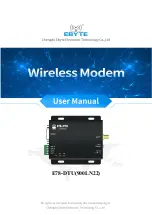
Powercom 485
9
Description and operating instuctions
8
VAH
L
E
P
O
W
ER
C
O
M
®
,K
om
.-
N
r.
00
000nn
nnn
0
6P
C
-E
N
-009_
23-
0
9-
20
14.
fm
,
S
tand:
2
3.
09.
2014
If you wish to know how two different types cable need to be routed, then proceed
as follows:
1. Look up cable type of first cable in column 1 (Cables for ...).
2. Look up cable type of second cable in the associated section of column 2 (and
cables for...).
3. In column 3 (routing ...): read off the routing guidelines to be observed.
–
Mark all lines leading to the VAHLE POWERCOM
®
485 device.
–
Provide suitable surge arrestors for all lines which may be exposed to lightning
strikes.
Cables for ...
and cables for ...
routing ...
VAHLE POW-
ERCOM
®
Bus signals, shielded (PROFI-
BUS, Ethernet) Bus signals,
unshielded
(AS-Interface)
Data signals, shielded (PG,
counting inputs etc.) Analog
signals, shielded Direct vol-
tage (=60 V),
unshielded
process signals (=25 V),
shielded alternating voltage
(=25 V), unscreened
in separate bundles or cable
ducts (no minimum distance
required)
Direct voltage (>60 V and
=400 V), unscreened
Alternating voltage 50 / 60 Hz
(>25 V and =400 V), un-
screened
Within cabinets:
In separate bundles or cable
ducts (no minimum distance
required)
Outside cabinets:
On separate cable tracks with
a spacing of at least 10 cm
VAHLE conductor rails:
Phase spacing of the relevant
system
Direct and alternating voltage
with fast switching sequences
such as e.g. converter cables.
In separate bundles, cable
with ducts or on separate ca-
ble tracks with a spacing of at
least 10 cm.
Conductor rails:
separate system with a spa-
cing of at least 50 cm


































